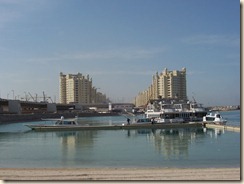 I will be leaving next week for a three week trip to the Persian Gulf region. When a number of my friends heard about this trip, their responses were, “How can you go there now? It’s too dangerous.” This response is not unusual when one is preparing for a trip to the Middle East. However, the recent uprisings in Tunisia and Egypt have spread to other countries in the region and have raised the level of concern.
I will be leaving next week for a three week trip to the Persian Gulf region. When a number of my friends heard about this trip, their responses were, “How can you go there now? It’s too dangerous.” This response is not unusual when one is preparing for a trip to the Middle East. However, the recent uprisings in Tunisia and Egypt have spread to other countries in the region and have raised the level of concern.
These popular uprisings started as economic based movements, but quickly changed into political movements demanding radical regime change. There has been a rise of a cultural sense of empowerment among the youth. The wall of fear of the repressive regimes has fallen and the movements have been transformed into formidable forces threatening previously entrenched governments.
This is particularly true in the case of Egypt which is a cornerstone of US Middle East foreign policy. Regardless of whether a true democracy, representative of all Egyptians, emerges or whether the US and its Western allies are able to orchestrate a “faux democracy” controlled by the army and regime loyalists, the risk reward calculations of authoritarian regimes in the region have changed dramatically. Over past decades regimes trying to decide whether to anger their citizens by supporting unpopular US policies or to anger their western patrons, have chosen to anger their citizens. This choice will now be much more difficult.
The situation in the oil rich Persian Gulf countries that I will be visiting, UAE, Qatar, Bahrain and Oman, is considerably different from that in their neighbors in North Africa and the Levant. Oil revenues have allowed their small indigenous populations to be relatively wealthy. The working class is largely made up of migrant workers from places such as India and the Philippines who, if they are upset with their economic circumstances don’t take to the street, but merely go home.
Of these states Oman and Bahrain are most exposed to catching the “Tunisian virus”. Oman is ruled by 71 year old Sultan Qaboos bin Said who came to power in 1970 in a “palace coup” which overthrew his father. He has been an effective leader resolving decade’s long violence between nomadic desert tribes and coastal merchants and bringing economic prosperity. He is, however, unmarried with no children and no obvious successor. Whether or not tribal leaders will be able to peacefully orchestrate succession remains to be seen.
The situation in Bahrain, home to a large US Navy base, is more similar to that in Egypt, Jordan and Saudi Arabia than to the other Gulf States. Although the Muslim population of Bahrain is 2/3 Shia, the country is ruled by the Sunni al Khalifa royal family. Recent elections have been marred by violence and repression. Bahrain’s proximity to Iran gives the Iranians significant influence in the Shia community.
It will be a fascinating time to be in the region. For those who are interested, as internet access and circumstances permit, I will be posting my observations and thoughts here and here.